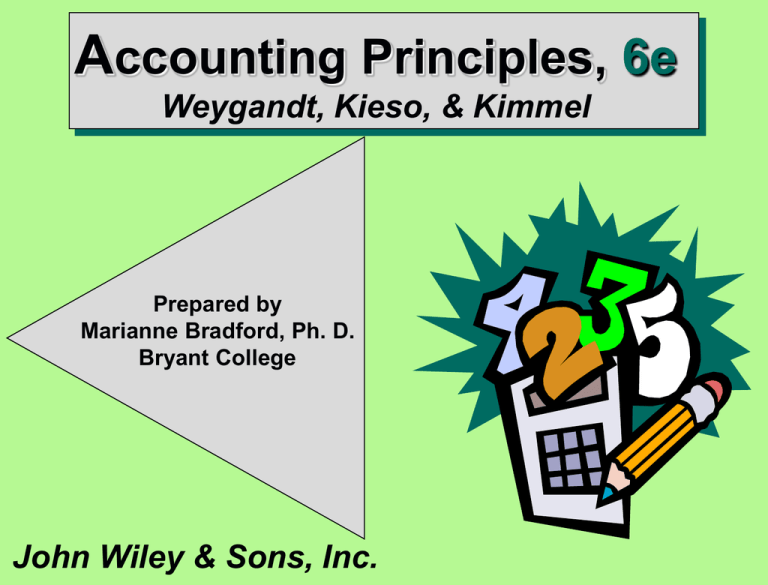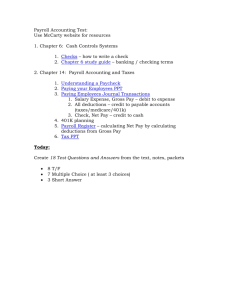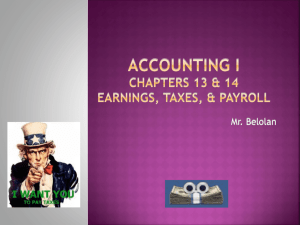
Accounting Principles, 6e
Weygandt, Kieso, & Kimmel
Prepared by
Marianne Bradford, Ph. D.
Bryant College
John Wiley & Sons, Inc.
CHAPTER 11
CURRENT LIABILITIES AND
PAYROLL ACCOUNTING
After studying this chapter, you should be able to:
1 Explain a current liability, and identify the
major types of current liabilities.
2 Describe the accounting for notes payable.
3 Explain the accounting for other current
liabilities.
4 Explain the financial statement presentation
and analysis of current liabilities.
5 Describe the accounting and disclosure
requirements for contingent liabilities.
CHAPTER 11
CURRENT LIABILITIES AND
PAYROLL ACCOUNTING
After studying this chapter, you should be able to:
6 Discuss the objectives of internal control for
payroll.
7 Compute and record the payroll for a pay
period.
8 Describe and record employer payroll taxes.
9 Identify additional fringe benefits associated
with employee compensation.
PREVIEW OF CHAPTER 11
CURRENT LIABILITIES AND
PAYROLL ACCOUNTING
Accounting for
Current Liabilities
Contingent
Liabilities
Notes payable
Recording
Sales taxes payable
Disclosure
Unearned revenues
Current maturities
of long-term debt
Financial statement
presentation and
analysis
Payroll
Accounting
Internal control
Determining payroll
Recording payroll
Employer payroll taxes
Filing and remitting
payroll taxes
Additional fringe
benefits
STUDY OBJECTIVE 1
................................
1 Explain a current liability and
identify the major types of current
liabilities.
ACCOUNTING FOR
CURRENT LIABILITIES
A Current Liability is a debt with two key features:
1) It can reasonably be expected to be paid from
existing currents assets or through the creation of
other current liabilities
2) It will be paid within one year or the operating
cycle, whichever is longer.
Current liabilities include:
1) Notes Payable
2) Accounts Payable
3) Unearned Revenues
4) Accrued Liabilities
STUDY OBJECTIVE 2
................................
2 Describe the accounting for note
payable.
NOTES PAYABLE
Notes Payable are obligations in the form of
written promissory notes that usually require the
borrower to pay interest.
Notes payable may be used instead of accounts
payable because it supplies the lender formal proof of
the obligation in case legal remedies are
needed to collect the debt.
Notes due for payment within one year
of
the balance sheet date are usually
classified as current liabilities.
NOTES PAYABLE
General Journal
Date
Account Titles
March 1 Cash
Notes Payable
Debit
Credit
100,000
100,000
When an interest-bearing note is issued, the assets received
generally equal the face value of the note. Assume First
National Bank agrees to lend $100,000 on March 1, 2002, if
Cole Williams Co. signs a $100,000, 12%, 4-month note.
Cash is debited and Notes Payable is credited.
Illustration 11-1
Formula for computing interest
The formula for computing interest
and its application to Cole Williams Co.
are shown below:
Face Value
of Note
$100,000 x
Annual
Interest
Rate
12%
Time in
Terms
of One Year
x
4/12 =
Interest
$4,000
NOTES PAYABLE
General Journal
Date
Account Titles
June 30 Interest Expense
Interest Payable
Debit
Credit
4,000
4,000
Interest accrues over the life of the note and must be
recorded periodically. If Cole Williams Co. prepares
financial statements semiannually, an adjusting entry is
required to recognize interest expense and interest payable
of $4,000 at June 30.
NOTES PAYABLE
General Journal
Date
July 1
Account Titles
Notes Payable
Interest Payable
Cash
Debit
Credit
100,000
4,000
104,000
At maturity, Notes Payable is debited for the
face value of the note, Interest Payable is
debited for the amount of accrued interest,
and Cash is credited for the maturity value
of the note.
STUDY OBJECTIVE 3
................................
3 Explain the accounting for
other current liabilities.
SALES TAXES PAYABLE
Sales tax is expressed as a stated percentage of the
sales price on goods sold to customers by a retailer.
The retailer collects the tax from the customer
when the sale occurs. The retailer periodically
(usually monthly) remits the collections to the
state’s department of revenue.
Thus, the retailer serves only as a
collection agent for the taxing
authority.
SALES TAXES PAYABLE
General Journal
Date
Mar. 25
Account Titles
Cash
Sales
Sales Tax Payable
Debit
Credit
10,600
10,000
600
Cash register readings are used to credit Sales and Sales Taxes
Payable. If on March 25th cash register readings for Cooley
Grocery show sales of $10,000 and sales taxes of $600 (sales tax
rate is 6%), the entry is a debit to Cash for the total, and a
credit to Sales for the actual sales and Sales Taxes Payable for
the amount of the sales tax.
SALES TAXES PAYABLE
When sales taxes are not rung up separately on the
cash register they must be extracted from the total
receipts. To determine the amount of sales in such
cases divide total receipts by 100% plus the sales tax
percentage to determine the sales, and the difference
is sales tax.
If Cooley Grocery “rings up” total receipts, which
are $10,600, and the sales tax percentage is 6%, we
can figure sales as follows:
$10,600
÷
1.06
=
$10,000
UNEARNED REVENUES
Unearned Revenues (advances from customers) occur
when a company receives cash before a service is
rendered.
Examples are when an airline sells a ticket for future
flights or when an attorney receives legal fees before
work is done.
UNEARNED REVENUES
General Journal
Date
Aug. 6
Account Titles
Cash
Unearned Football Ticket
Revenue
Debit
Credit
500,000
500,000
If Superior University sells 10,000 season football tickets
at $50 each for its five-game home schedule, the entry for
the sale of the tickets is a debit to Cash for the advance
received, and a credit to Unearned Football Ticket
Revenue, a current liability.
UNEARNED REVENUES
General Journal
Date
Sept. 7
Account Titles
Unearned Football Ticket Revenue
Football Ticket Revenue
Debit
Credit
100,000
100,000
As each game is completed, the Unearned Football Ticket
Revenue account is debited for 1/5 of the unearned revenue,
and the earned revenue, Football Ticket Revenue, is
credited.
Illustration 11-2
Unearned and earned revenue
accounts
Shown below are specific unearned and earned
revenue accounts used in selected types of
businesses.
Account Title
Type of Business Unearned Revenue
Unearned passenger
Airline
Ticket Revenue
Unearned
Magazine
Subscription
Publisher
Revenue
Unearned Rental
Hotel
Revenue
Insurance
Unearned Premium
Company
Revenue
Earned Revenue
Passenger
Revenue
Subscription
Revenue
Rental Revenue
Premium Revenue
CURRENT MATURITIES OF
LONG-TERM DEBT
Another item classified as a current liability
is current maturities of long-term debt.
Current maturities of long-term debt are
often termed long-term debt due within one
year.
STUDY OBJECTIVE 4
................................
4 Explain the financial statement
presentation and analysis
of current liabilities.
FINANCIAL STATEMENT
PRESENTATION
Current liabilities are the first category under liabilities on
the balance sheet. Each of the principal types of current
liabilities is listed separately.
Current liabilities are seldom listed in the order of maturity.
The reason is that varying maturity dates may exist for
specific obligations such as notes payable.
A more common method of presenting current liabilities is to
list them by order of magnitude, with the largest ones first.
However, many companies, as a matter of custom, show notes
payable and accounts payable first regardless of amount.
The following adapted slide from the balance sheet of Lands’
End, Inc., illustrates the order of presentation.
ILLUSTRATION 11-3
BALANCE SHEET PRESENTATION
OF CURRENT LIABILITIES
Lands' End, Inc.
Balance Sheet
January 28, 2000
(in millions)
Assets
Current assets
Property, plant, and equipment (net)
Intangibles (net)
Total assets
$289.40
165.80
1.00
456.20
Liabilities and Stockholders' Equity
Current liabilities
Lines of credit
11.70
Accounts payable
74.50
Reserve for returns
7.90
Accrued liabilities
43.80
Accrued profit sharing
2.70
Income taxes payable
10.30
Total current liabilities
Noncurrent liabilities
Shareholders' equity
Total liabilities and stockholders' equity
150.90
9.10
296.20
$456.20
Illustration 11-4
Working Capital formula and
computation
The excess of current assets over
current liabilities is working capital. The
formula for the computation of Lands’
End, Inc. working capital is shown
below.
Current
Assets
$ 289.40
-
Current
Liabilities
=
Working
Capital
- $ 150.90 = $ 138.50
Illustration 11-5
Current ratio and computation
The current ratio permits us to compare
the liquidity of different sized
companies and of a single company at
different times. The current ratio for
Lands’ End, Inc. is shown below.
Current
Assets
$289.40
Current
Liabilities
=
Current
Ratio
/ $150.90
=
1.9:1
/
STUDY OBJECTIVE 5
................................
5 Describe the accounting and disclosure
requirements for contingent liabilities.
CONTINGENT LIABILITIES
A contingent liability is a potential liability that may
become an actual liability in the future.
The accounting guidelines require that:
1 If the contingency is probable and the amount can
be reasonably estimated, the liability should be
recorded in the accounts.
2 If the contingency is only reasonably possible, then
it need be disclosed only in the notes that accompany
the financial statements.
3 If the contingency is remote, it need not be recorded
or disclosed.
PRODUCT WARRANTIES
Product warranties are an example of a
contingent liability that should be record in the
accounts.
The estimated cost of honoring product warranty
contracts should be recognized as an expense in
the period in which the sale occurs.
Warranty Expense is reported under selling
expenses in the income statement, and
estimating warranty liability is classified
as a current liability on the balance sheet.
ILLUSTRATION 11-6
COMPUTATION OF ESTIMATED
PRODUCT WARRANTY LIABILITY
In 2002 Denson Manufacturing Company sells 10,000
washers and dryers at an average price of $600 each. The
selling price includes a one-year warranty on parts. It is
expected that 500 units (5%) will be defective and that
warranty repair costs will average $80 per unit. The
calculation of of estimated product costs on 2002 sales is as
follows:
Number of units sold
Estimated rate of defective units
Total estimated defective units
Average warranty repair cost
Estimated product warranty liability
10,000
X
5%
500
X $
80
$ 40,000
ENTRIES TO RECORD
WARRANTY COSTS
General Journal
Date
Dec 31.
Account Titles
Warranty Expense
Estimated Warranty Liability
Debit
Credit
40,000
40,000
Denson Manufacturing Company makes the
adjusting entry above to accrue the estimated
warranty costs on 2002 sales. Warranty Expense is
debited while Estimated Warranty Liability is
credited for $40,000 at December 31.
ENTRIES TO RECORD
WARRANTY COSTS
General Journal
Date
Jan. 1Dec. 31
Account Titles
Estimated Warranty Liability
Repair Parts
Debit
Credit
24,000
24,000
Denson Manufacturing Company makes the
$24,000 (300 X $80) summary entry above to
record repair costs incurred in 2002 to honor
warranty contracts on 2002 sales. Estimated
Warranty Liability is debited while Repair Parts
is credited at December 31.
ENTRIES TO RECORD
WARRANTY COSTS
General Journal
Date
Jan. 31
Account Titles
Estimated Warranty Liability
Repair Parts
Debit
Credit
1,600
1,600
Denson Manufacturing Company replaced
defective units in January 2003 for $1,600 (20 X
$80) and made the summary entry above.
Estimated Warranty Liability is debited while
Repair Parts is credited.
STUDY OBJECTIVE 6
................................
6 Discuss the objectives of
internal control for payroll.
PAYROLL ACCOUNTING
The term payroll pertains to both salaries and
wages.
Managerial, administrative, and sales
personnel are generally paid salaries. Salaries
are often expressed in terms of a specified amount per
month or year.
Store clerks, factory employees and manual laborers are
normally paid wages, which are based on a rate per hour.
Payments made to professional individuals who
are independent contractors are called fees.
Government regulations relating to the payment
and reporting of payroll taxes apply only to employees.
INTERNAL CONTROLS
FOR PAYROLL
The objectives of internal accounting control
concerning payroll are:
1 to safeguard company assets from unauthorized
payments of payrolls and
2 to ensure the accuracy and reliability of the
accounting records pertaining to payrolls.
Payroll activities involve four functions:
1 hiring employees,
4 Functions
2 timekeeping,
of Payroll
3 preparing the payroll, and
4 paying the payroll.
These functions should be assigned to
different departments or individuals.
HIRING EMPLOYEES
The human resources department is responsible for
ensuring the accuracy of the personnel authorization
form.
The human resources department is also responsible
for authorizing changes in employment status:
1 changes in pay rates
2 termination of employment.
TIMEKEEPING
Hourly employees are usually required to record time
worked by “punching” a time clock. Times of arrival
and departure are automatically recorded by the
employee by inserting a time card into the clock.
In large companies time clock procedures are often
monitored by a supervisor or security guard to make
sure an employee punches only one card.
The employee’s supervisor:
1 approves the hours shown by signing the time card
at the end of the pay period and
2 authorizes any overtime hours for an employee.
PREPARING THE PAYROLL
The payroll is prepared in the payroll
department on the basis of two inputs:
1 human resources department authorizations
2 approved time cards.
STUDY OBJECTIVE 7
................................
7 Compute and record the payroll
for a pay period.
DETERMINING AND PAYING
THE PAYROLL
Determining the payroll involves computing three
amounts:
1 gross earnings,
2 payroll deductions, and
3 net pay.
The payroll is paid by the treasurer’s department.
1 Payment by check minimizes the risk of loss from
theft and
2 the endorsed check provides proof of payment.
ILLUSTRATION 11-10
COMPUTATION OF TOTAL WAGES
Gross earnings is the total compensation earned by an
employee.
It consists of wages or salaries, plus any bonuses and
commissions.
Total wages are determined by multiplying the hours
worked by the hourly rate of pay.
Most companies are required to pay a minimum of
1 1/2 the regular hourly rate for overtime work.
Type of Pay
Regular
Overtime
Total wages
Hours
40
4
X
X
X
Rate
=
$ 12.00 =
18.00 =
Gross
Earnings
$ 480.00
72.00
$ 552.00
PAYROLL DEDUCTIONS
The difference between gross pay and
the amount actually received is
attributable to payroll deductions.
Mandatory deductions consist of
FICA taxes and income taxes.
The employer is merely a collection
agent and subsequently transfers the
amounts deducted to the government
and designated recipients.
ILLUSTRATION 11-11
PAYROLL DEDUCTIONS
SOCIAL SECURITY
225-61-9726
THIS NUMBER HAS BEEN ESTABLISHED FOR
John Edward Doe
SIGNATURE
FICA
Taxes
Insurance
and
Pensions,
Federal
Income
Tax
State &
City
Income
Taxes
Gross
Pay
Charity
Net
Pay
FICA TAXES
FICA taxes (or social security taxes) are designed
to provide workers with supplemental
retirement, employment disability, and
medical benefits.
The benefits are financed by a tax levied
on employees’ earnings.
The tax rate and tax base for FICA
taxes are set by Congress.
INCOME TAXES
Income Taxes are required to be withheld
from
employees each pay period and the
amount is
determined by 3 variables:
1 the employee’s gross earnings;
2 the number of allowances claimed by
the employee; and
3 the length of the pay period.
To indicate to the Internal Revenue Service the
number of allowances claimed, the employee must
complete an Employee’s Withholding Certificate
(Form W-4).
VOLUNTARY DEDUCTIONS
Voluntary Deductions pertain to
withholdings for charitable, retirement,
and other purposes.
All voluntary deductions from gross
earnings should be authorized in
writing by the employee.
For purposes of illustration, the
employee has the following voluntary
deductions – including $10 for United
Fund and $5 for union dues:
ILLUSTRATION 11-14
COMPUTATION OF NET PAY
Gross earnings
Payroll deductions:
FICA taxes
Federal income taxes
State income taxes
United Fund
Union dues
Net pay
$ 552.00
$ 44.16
49.00
11.04
10.00
5.00
119.20
$ 432.80
Net Pay (or take-home pay) is determined by subtracting payroll
deductions from gross earnings. Assuming an employee’s wages
are $552 each week, the employee will earn $28,704 for the year
(52 weeks X $552). Thus, all earnings are subject to FICA taxes.
RECORDING THE PAYROLL
The employee earnings record provides a cumulative
record of each employee’s gross earnings, deductions,
and net pay during the year. This record is used by
the employer to:
1 determine when an employee has earned
the maximum earnings subject to FICA taxes,
2 file state and federal payroll tax returns, and
3 provide each employee with a statement of gross
earnings and tax withholdings for the year.
Many companies use a payroll register to accumulate
the gross earnings, deductions, and net pay by
employee for each period.
RECOGNIZING PAYROLL
EXPENSES AND LIABILITIES
General Journal
Date
Jan 14
Account Titles
Debit
Credit
Office Salaries Expense
5,200.00
Wages Expense
12,010.00
FICA Taxes Payable
1,376.80
Federal Income Taxes Pay.
3,490.00
State Income Taxes Pay.
344.20
United Fund Pay.
421.50
Union Dues Pay.
115.00
Salaries and Wages Pay.
11,462.50
Academy Company records its payroll for the week ending January 14,
2002 with the journal entry above. Office Salaries Expense ($5,200) and
Wages Payable ($12,010) are debited in total for $17,210 in gross earnings.
Specific liability accounts are credited for the deductions made during the
pay period. Salaries and Wages Payable is credited for $11,462.50 in net
earnings.
RECORDING PAYMENT
OF THE PAYROLL
General Journal
Date
Account Titles
Jan. 14
Salaries and Wages Pay.
Cash
Debit
Credit
11,462.50
11,462.50
The entry to record payment of the Academy
Company payroll is a debit to Salaries and Wages
Payable and a credit to Cash. When currency is
used in payment, one check is prepared for the
amount of net earnings ($11,462.50).
STUDY OBJECTIVE 8
................................
8 Describe and record employer
payroll taxes.
EMPLOYER
PAYROLL TAXES
Payroll Tax Expense for businesses results from three
taxes levied on employers by governmental agencies.
1 The employer must match each employee’s FICA
contribution – resulting in payroll tax expense to the
employer.
2 Federal unemployment taxes (FUTA) provide benefits
for a limited time period to employees who lose their
jobs through no fault of their own. FUTA is a tax
borne entirely by the employer.
3 State unemployment taxes (SUTA) also provide
benefits to employees who lose their jobs.
RECORDING EMPLOYER
PAYROLL TAXES
The entry to record the payroll tax expense associated with
the Academy Company payroll results in a debit to Payroll
Tax Expense for $2,443.82, a credit to FICA Taxes Payable
for $1,376.80 ($17,210 X 8%), a credit to FUTA Payable for
$137.68 ($17,210 X 0.8%), and a credit to SUTA Payable
for $929.34 ($17,210 X 5.4%).
General Journal
Date
Jan 14.
Account Titles
Payroll Tax Expense
FICA Taxes Pay.
Federal Unemployment Taxes Pay.
State Unemployment Taxes Pay.
Debit
Credit
2,443.82
1,376.80
137.68
929.34
FILING AND REMITTING
PAYROLL TAXES
Preparation of payroll tax returns is the responsibility of
the payroll department. Payment of the taxes is made by
the treasurer’s department.
FICA taxes and Federal income taxes (FIT) withheld are
combined for reporting and remitting purposes.
The taxes are reported quarterly – no later than one
month after the close of each quarter.
FUTA taxes are generally filed and remitted annually on
or prior to January 31 of the subsequent year.
SUTA taxes must be filed and paid by the end of the
month following each quarter.
The employer is required to provide each employee with a
Wage and Tax Statement (Form W-2) by January 31
following the end of the calendar year.
STUDY OBJECTIVE 9
................................
9 Identify additional fringe benefits
associated with employee compensation.
ADDITIONAL FRINGE BENEFITS
PAID ABSENCES
Employees often are given rights to receive compensation for absences
when certain conditions of employment are met. Such compensation
may relate to 1) paid vacations, 2) sick pay benefits, and 3) paid
holidays. A liability should be accrued for paid future absences if 1) its
payment is probable and 2) the amount can be reasonably estimated.
Academy Company employees are entitled to one day’s vacation for
each month worked. If 30 employees earn an average of $110 per day
in a given month, the accrual for vacation benefits for January is $3,300
($110 X 30). The liability is recognized at January 31 by the following
adjusting entry:
General Journal
Date
Jan. 31
Account Titles
Vacation Benefits Exp.
Vacation Benefits Pay.
Debit
Credit
3,300
3,300
ADDITIONAL FRINGE BENEFITS
PAID ABSENCES
When vacation benefits are paid, Vacation
Benefits Payable is debited and Cash is
credited. If Academy Company pays such
benefits for 10 employees in July, the journal
entry to record the payment is for $1,100 ($110
X 10).
General Journal
Date
Account Titles
July 31 Vacation Benefits Pay.
Cash
Debit
Credit
1,100
1,100
POSTRETIREMENT
BENEFITS
Postretirement benefits are benefits
provided by employers to retired
employees for:
1 health care and life insurance
2 pensions
Both types of postretirement
benefits are accounted for on
the accrual basis.
PENSION PLANS
A pension plan is an agreement whereby an employer
provides benefits to employees after they retire.
Three parties are generally involved in a pension plan.
1) The employer sponsors the pension plan.
2) The plan administrator receives the contributions
from the employer, invests the pension assets, and
makes the benefit payments.
3) The retired employees receive
the pension payments.
ILLUSTRATION 11-20
PARTIES IN A PENSION PLAN
Employer
Benefits
Plan
Administrator
Pension Recipients
Contributions
COPYRIGHT
Copyright © 2002 John Wiley & Sons, Inc. All rights reserved. Reproduction
or translation of this work beyond that permitted in Section 117 of the 1976
United States Copyright Act without the express written consent of the
copyright owner is unlawful. Request for further information should be
addressed to the Permissions Department, John Wiley & Sons, Inc. The
purchaser may make back-up copies for his/her own use only and not for
distribution or resale. The Publisher assumes no responsibility for errors,
omissions, or damages, caused by the use of these programs or from the
use of the information contained herein.
CHAPTER 11
CURRENT LIABILITIES AND
PAYROLL ACCOUNTING






